United States Air Force Special Forces SV-22 Osprey
Creation and adoption of the Osprey convertiplane
After the failure in the 1980 year of the operation to free American hostages in Iran, the leadership of the US Defense Ministry expressed interest in an aircraft capable of vertical takeoff and landing and at the same time have a cruising flight speed and range comparable to the Hercules turboprop. An aircraft combining the capabilities of an airplane and a helicopter, built as part of the JVX (Joint-service Vertical take-off / landing Experimental) program jointly by Bell Helicopter and Boeing Helicopters and named V-22 Osprey Osprey - Osprey), first flew 19 March 1989 year.
Osprey became the first serial tiltrotor in the world - an aircraft capable of vertical takeoff and landing (as helicopters do) and a long high-speed horizontal flight, which is typical for ordinary aircraft. Since the tiltrotor is not fully a helicopter or an airplane, this affected both its design and appearance. According to the layout scheme, the Osprey is a high-wing aircraft with a two-fin plumage, equipped with two Rolls-Royce T406 turboprop engines located at the ends of the wing in nacelles, which can rotate by almost 98 degrees. The rotation of the nacelles is carried out using a hydraulic actuator with a screw mechanism. The screws with three trapezoidal blades are interconnected by a synchronizing shaft, which passes inside the wing. This shaft provides the possibility of controlled flight and landing of the aircraft on one engine. To reduce the size of the aircraft while stationary, the wing rotates, the screws fold. In order to reduce the mass of the structure, about 70% (5700 kg) of the apparatus is made of composite materials based on carbon and fiberglass with an epoxy binder, which makes it approximately 25% lighter than metal.
From the very beginning, the implementation of the turboprop aircraft program, which began in the first half of the 1980's, progressed with great difficulty and was repeatedly threatened with closure. This was due to the large share of fundamentally new technical solutions and the high accident rate of prototypes and the first production copies. A major blow to the project was the refusal of the US Army to continue financing. Air Force officials were also critical of Osprey. The further implementation of the program was insisted by the command of the Marine Corps, which needed to replace the CH-46 Sea Knight helicopters, whose life was coming to an end.
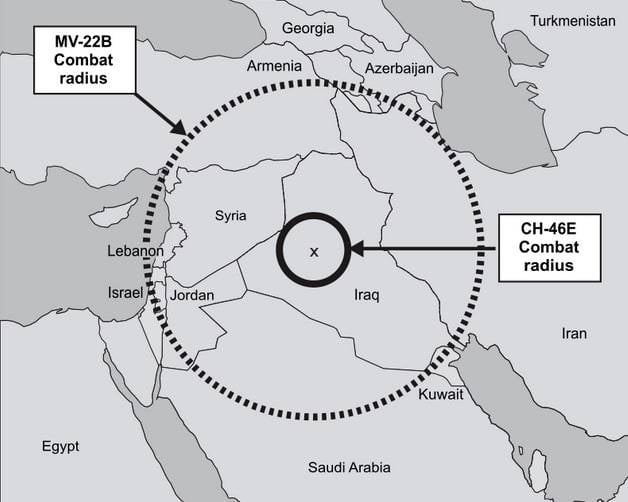
The main argument in this case, despite its higher cost, was a significantly increased combat radius and approximately twice as high flight speed in cruising mode, which allowed faster transfer of marines and cargo from the UDC to the landing zone.
After a series of accidents and disasters, most of the problems associated with the technical reliability of Osprey were resolved, and in the 2005, the Pentagon approved a production plan. In 2008, the US military entered into a contract for the supply of 167 V-22 Osprey convertibles for a total of $ 10,4 billion. In 2013, the United States Department of Defense decided to increase the number of Osprey purchases to 458 units. Of these, 360 are for the U.S. ILC, 50 for the Air Force and 48 for the Navy. The cost of one CV-22B, adopted by the Special Forces Aviation Command in the 2014 year, amounted to $ 76 million.
Operation of convertibles CV-22 in the US Air Force MTR in combat squadrons
The first Osprey was handed over to the 58 Special Operations Wing at Kirtland Air Base in New Mexico on 20 on March 2006. This machine was used to train pilots and crew. On November 16 on November 2006, the U.S. Air Force officially accepted the CV-22 at a ceremony held in Hurlburt Field, Florida. 4 October 2007 year, the tiltrotor was first used in a real search and rescue operation. On 16 on March 2009, the command of the Air Force MTR announced that the first six CV-22s of the 8th Special Operations Squadron, based at the Helbert Field Air Base, were ready for combat missions.
In June 2009, Osprey took part in a humanitarian operation in Honduras, delivering about 20 tons of food and medicine to remote villages. In 2009, CV-22 was deployed in Iraq in the 8 Squadron, and in Afghanistan in the 2010 Squadron. On July 3 of 2014, CV-22B landed special forces of the Delta Force unit in the vicinity of the militant camp in eastern Syria, where, according to intelligence, the hostages were held. Commandos liquidated the militants on the spot, but found that the hostages had been moved to another place and returned home empty-handed. In general, convertiplanes in Iraq and Afghanistan showed themselves well. According to American data, the coefficient of their technical readiness did not fall below 0,6.
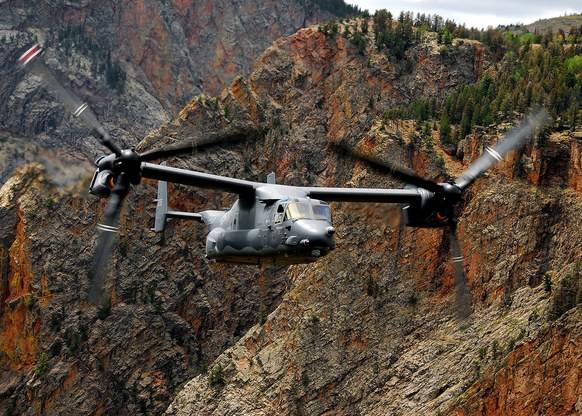
According to its characteristics, the CV-22B fully complied with the requirements of special operations forces. It was especially noted that the Osprey, unlike helicopters, easily overcame mountain ranges, and its range was significantly higher, but it was more demanding on landing sites.
Design features and characteristics of the CV-22B
In terms of mass and dimensions, the CV-22B is close to the MH-2008J Pave Low III special-purpose heavy helicopter taken out of service in the 53, but significantly exceeds it in speed and flight range. The mass of the empty tiltrotor is 15 000 kg. Maximum takeoff weight - 27 440 kg. The mass of the load on the external sling is 6140 kg, the inside of the cargo compartment is 9000 kg. Crew - 4 person. In a cabin measuring 7,37x1,53x1,3m, 24,3m³ in volume, 24 fully equipped paratroopers or 12 wounded on a stretcher with accompanying paramedics can be accommodated. The practical ceiling is 7620 m. The maximum speed in airplane mode is 565 km / h; in helicopter mode, 185 km / h. The wing span at the ends of the propeller blades is 25,78 m. The length for folded blades is 19,23 m. The width for folded blades is 5,64 m. The height for keels is 5,38 m.
The CV-22B used by the Air Force MTR is different from the MV-22B purchased by the US Marine Corps, a more advanced avionics and increased fuel supply. The CV-22B avionics in the basic version included TACAN, VOR / ILS and GPS navigation systems, VHF and HF radio communication equipment, identification systems and night vision equipment. When designing the Osprey, a “glass cockpit” was used, designed for the CH-46X helicopter, which was not put into mass production.
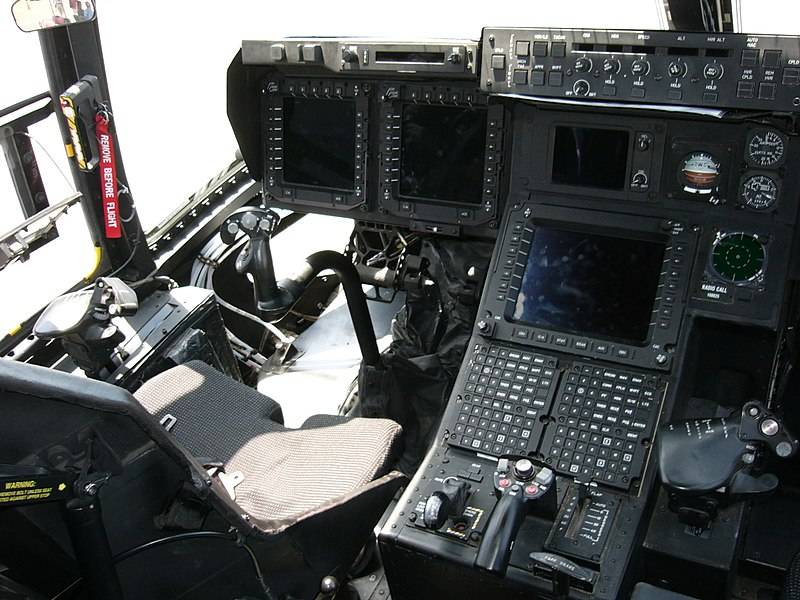
Flight information is displayed on four color displays. In the cockpit there is a fifth display - to display a map of the area. To ensure flights in the following terrain, there is an AN / ARO-174 radar, which can also be used to map the earth's surface. Subsequently, the avionics CV-22B, designed to perform secret missions over the territory of the enemy, underwent significant improvement, the cabin equipment was improved and new software was developed.
Compared to the Osprey, supplied by the United States ILC, special operations force convertiplanes have an increased fuel supply. The fuel tanks MV-22B, designed primarily for the transfer of marines and cargo from universal landing ships, carry 6513 liters of aviation kerosene, and the full refueling tanks CV-22B - 7710 liters. In addition, the Osprey MTR of the US Air Force can carry three outboard fuel tanks with a capacity of 1628 l. For distillation flights in the cargo compartment, it is possible to install additional fuel tanks with a total fuel capacity of 7235 l. The combat radius of action without refueling in the air is about 800 km. Ferry range - 3890 km.
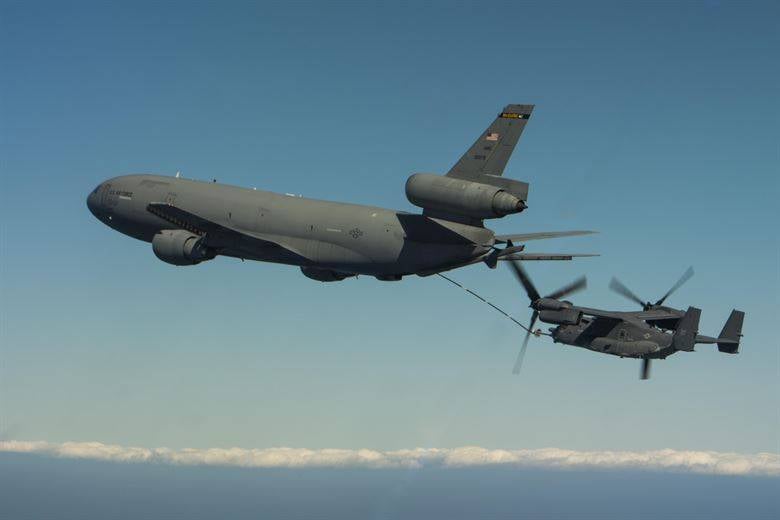
Currently, the CV-22B can receive in-flight aviation fuel from all US Air Force MTR refueling tanks built on the basis of the C-130 turboprop. Also confirmed was the ability to refuel from regular flying tankers of the U.S. Air Force: KC-135, KC-10 and KC-46.
Losses of CV-22B
Although after the adoption of the Osprey into service in special aviation, all heavy MH-53 Pave Low helicopters were decommissioned and the MS-130 aircraft were partially suppressed, the Air Force command had many complaints about the level of technical reliability and flight safety. From the very first test flights, the Osprey gained notoriety. In various flight accidents, 12 V-22 of various modifications were defeated, and 42 people died. Four Osprey lost during testing, and the rest after adoption. However, despite a number of serious incidents, the Air Force MTR irretrievably lost only two convertiplanes. 9 April 2010 years, as a result of the fall of CV-22, 3 American soldiers and one civilian were killed, another 16 Americans were injured. The cause of the crash was the erroneous actions of pilots in conditions of poor visibility, loss of situational awareness and a high rate of decline. On June 13 of 2012 of the year SV-22, which crashed as a result of a pilot error in the vicinity of Eglin air base was not subject to recovery, but all those on board survived.
Improved flight performance and survivability CV-22B
At the same time, the SV-22B used by special forces repeatedly demonstrated good survivability. So, in December 2013, three convertiplanes involved in the evacuation of American citizens in South Sudan received damage as a result of shelling from the ground from a rifle weapons. Subsequently, after returning, 119 holes were counted in their casing, which led to damage to the fuel and hydraulic systems. Despite the damage, the CV-22B managed to continue controlled flight. In order for Osprey to cover the distance of 800 km and land at the Entebbe airport in Uganda, they had to be refueled several times in the air from an MS-130Н aircraft.
Based on the results of use in the combat zone, the High Command of the United States Air Force demanded that the CV-22B be finalized. To increase combat survivability. First of all, it was necessary to eliminate the fuel leak during the shooting of the tanks and to establish ballistic protection for the cabin and the most vulnerable parts of the structure. In 2015, ballistic protection kits consisting of 16 ceramic-metal plates were installed on the first 22 CV-66B MTR of the US Air Force. The mass of armor was 360 kg, with the cost of one set of $ 270 000. In view of the reduction in payload and the reduction in flight range, it was decided to equip only the Osprey directly involved in the hostilities. The fall in flight data that occurred after the installation of the armor was partially compensated by increasing the power of the AE-1107C engines by 17%. This was achieved thanks to the modernization of the turbine and fuel equipment, while updating the software. As a result, the cruising flight speed was increased from 446 to 470 km / h.
Equipping convertiplanes with weapons and anti-aircraft defense systems
For self-defense of the CV-22В, when fired from the ground, various options for installing weapons were considered. Most often, on the Osprey, flying in Afghanistan and Iraq, in the rear mounted 7,62-mm machine guns M240 (American version of the FN MAG), as well as 12,7-mm single-barrel M2 and three-barrel GAU-19.
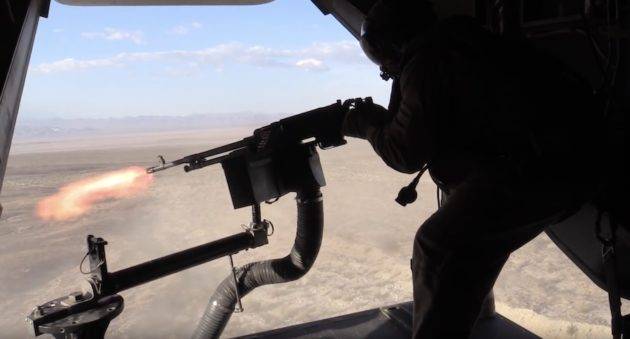
To increase the impact capabilities, tests were carried out with AGM-114 Hellfire ATGMs, AGM-176 Griffin small-precision high-precision aviation ammunition and GBU-53 / B adjustable bombs -7,62 B / A, served by a shooter, at the disposal of which there was an optoelectronic sighting and search system with a night channel.
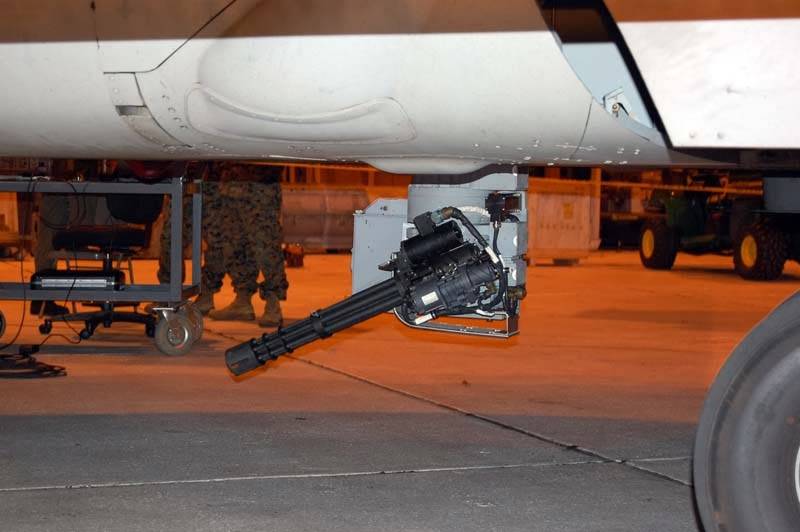
However, the IDWS weapons system did not prove itself in Afghanistan. First of all, this was due to the fact that the American command began to plan flights very carefully, clean up the territory where the special forces landed, and accompany the tilt planes with attack helicopters and attack aircraft. In addition, by that time, the Taliban, having experienced the impact power of American military aviation, began to avoid an open collision. As a result, the main stake in reducing the vulnerability of CV-22B was placed on the reservation and installation of advanced passive defense systems. The upgraded Osprey, operating in the interests of the Special Operations Forces, is equipped with AN / ALQ-211 broadband digital reception equipment, which in radio-frequency conditions analyzes radio frequency emissions and can neutralize dipole reflectors or use jammers to neutralize threats. Heat traps and the AN / AAQ-24 Nemesis laser counteraction system are designed to counter missiles that are guided by the thermal signature of the engines.
Immediate prospects for the use of convertiplanes in the US Air Force
Although the number of Osprey in the US Air Force is relatively small, they play a measuring role in supporting the combat operations of special operations forces. The commissioning of the CV-22B allowed the dismissal of the MS-130Е Combat Talon I aircraft and the MH-53 Pave Low helicopters. The tiltrotors also noticeably replaced the HH-60G Pave Hawk helicopters in the search and rescue squadrons. It is planned that the faster, faster CV-22C tiltrotor planes will operate in conjunction with the HH-60W helicopters, which are planned to replace the HH-60G. For refueling in the air of MN-60 special forces helicopters and NN-60 search and rescue helicopters in the future, the CV-22С should receive refueling equipment similar to that used on KC-130J aircraft. Improving the flight, operational and combat characteristics of the upgraded CV-22С should primarily occur due to an increase in engine power by 25% and the use of more advanced avionics and armament.
To be continued ...
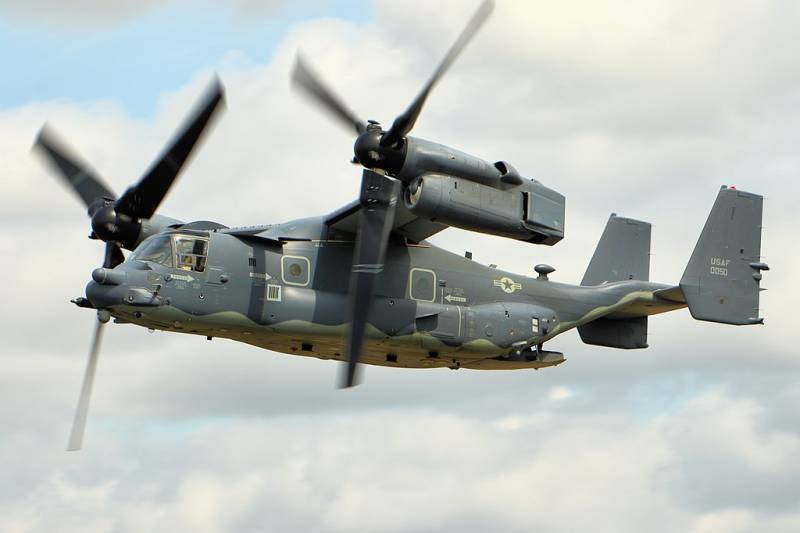
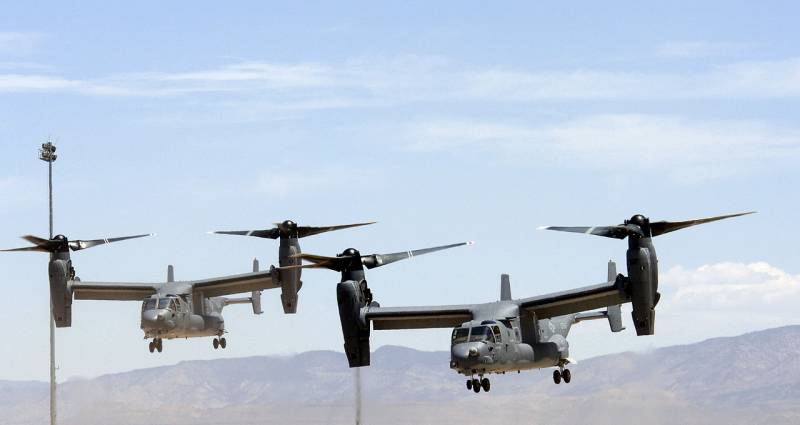
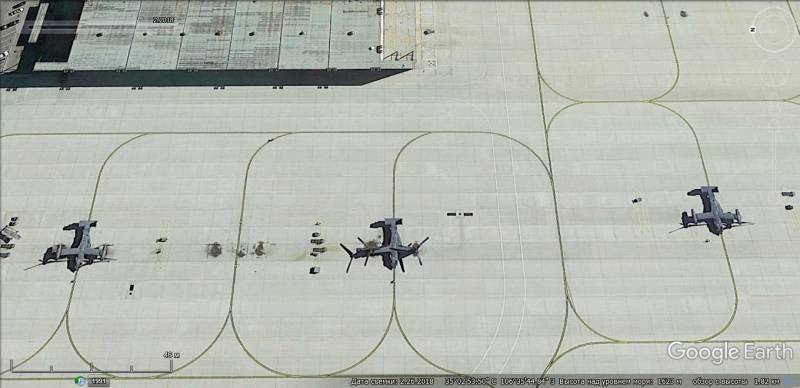
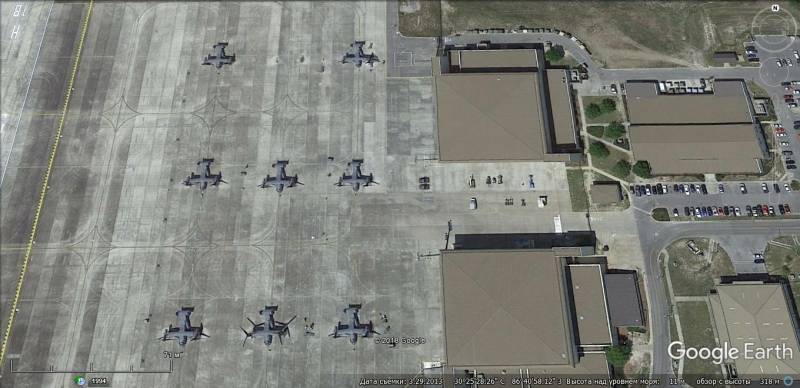
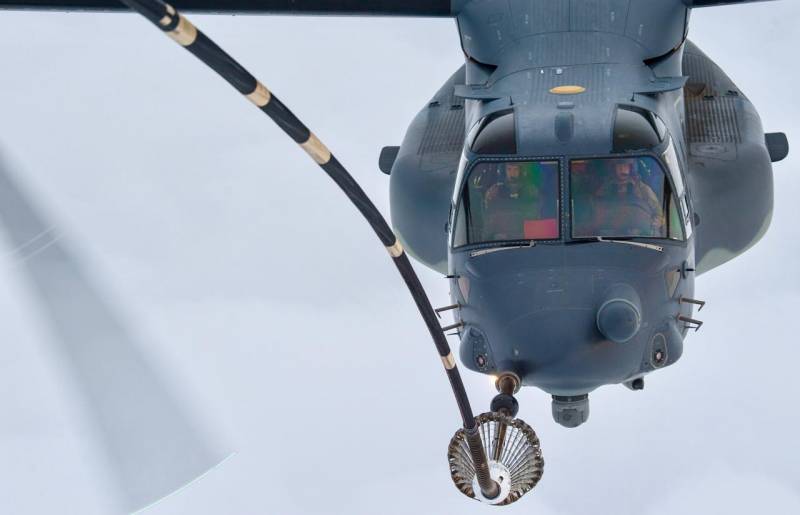
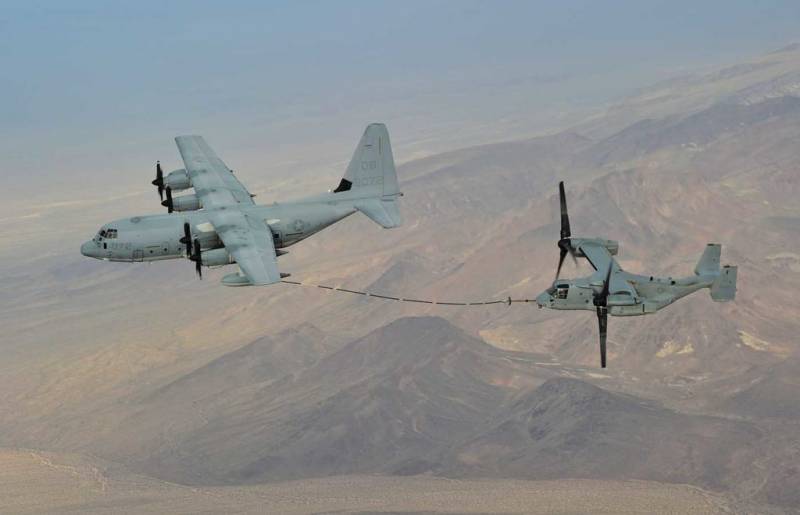
Information